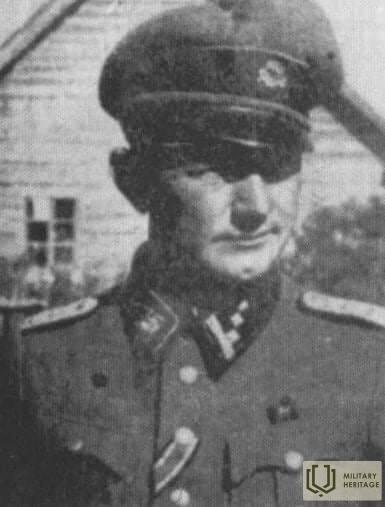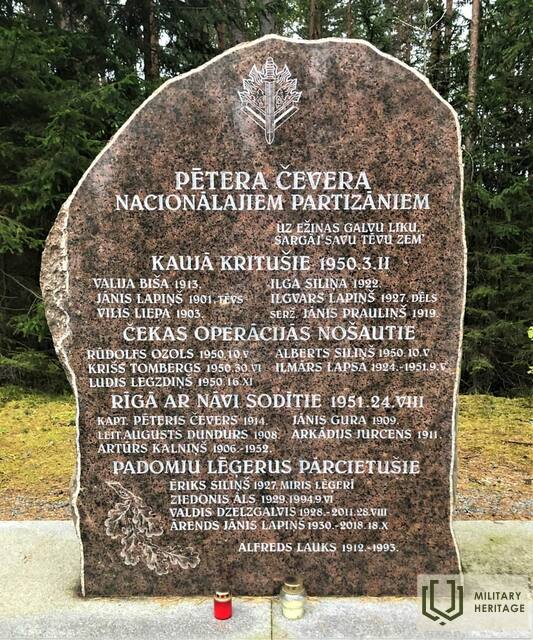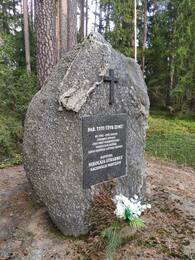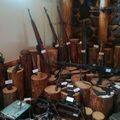Pēteris Čeversas – nacionalinis partizanas ir partizanų būrio vadas
Pēteris Čevera – nacionalinis partizanas ir nacionalinių partizanų būrio vadas
Pēteris Čeversas gimė 1914 m. sausio 9 d. Barkavos valsčiuje, Rėzeknės apskrityje.
Jis baigė Karo mokyklą 1937 m. ir tarnavo 1-ajame kavalerijos pulke iki 1940 m.
Po sovietų okupacijos, 1941 m. pavasarį, buvo perkeltas į 24-ojo teritorinio šaulių korpuso 186-ąjį pėstininkų pulką.
1941 m. birželio 14 d. Ostrovo stovykloje, išgirdęs apie areštus, kartu su keliais kitais karininkais prisijungė prie pulkininko leitenanto Kārlio Aperāto vadovaujamo „Tėvynės sargų“ būrio.
1942 m. vasarį jis savanoriškai įstojo į 23-iąjį ordino tarnybos batalioną.
Nuo 1942 m. kovo iki 1943 m. vasario, po specialiųjų mokymų, tarnavo specialiųjų užduočių pulke „Brandenburg 800“.
1943 m. kovo mėn. jis įstojo į Latvijos SS savanorių legioną, vėliau tapo 19-osios divizijos 43-iojo pulko 14-osios prieštankinės kuopos vadu, su kuria žygiavo mūšio keliais nuo Velikų upės krantų iki Kuržemės. Jam buvo įteikti II ir I klasių Geležinis kryžius, Karinis nuopelnų kryžius ir Sidabrinis smūgio ženklas.
Vokiečių kariuomenei pasidavus Kurše, P. Cheveris kartu su keliais savo pulko karininkais ir kareiviais apsigyveno Talsų rajono Vandzenės parapijos miškuose, kur prisijungė prie kapitono Nikolajaus Straumės grupės. Nuo 1948 m. gegužės mėn. P. Čeveris tapo grupės vadu Vansienės ir kitų aplinkinių Talsų rajono parapijų teritorijoje.
Dėl išdavystės P. Cheveris ir dar šeši grupės nariai buvo sugauti 1950 m. lapkričio 1–2 d. naktį. 1951 m. balandžio 3 d. Baltijos karinės apygardos karinis tribunolas skyrė P. Cheveriui griežtesnę bausmę. Bausmė įvykdyta 1951 m. rugpjūčio 24 d.
Pēteris Čeversas buvo Latvijos armijos karys, Latvijos legiono kapitonas, nacionalinis partizanas (nuo 1945 m. gegužės 9 d.), nacionalinių partizanų būrio vadas (1948–1950 m.).
Vandzenės partizanai ir jų rėmėjai. Blumų šeimos tragedija ir „Valdų“ namų paslaptis / Straipsnis (lsm.lv)
Autorius: Uldis Neiburgs (hist. dr., Latvijos universiteto Latvijos istorijos instituto mokslo darbuotojas)
Susijusi laiko juosta
Susijusios temos
Susijusios vietos
Petro Čeverso nacionalinių partizanų bunkeris
Petro Čevero nacionalinių partizanų bunkeris yra Laucienės savivaldybėje, apie 4 km nuo Talsų–Upesgryvos kelio. Į jį veda medžio drožlėmis grįstas takas. Atnaujintas 31 kvadratinio metro ploto bunkeris pastatytas iš betoninio karkaso, apdailintas pusrąsčiais, kad būtų sukurtas autentiškas vaizdas.
Kapitono Čeverio grupė bunkerį miške netoli Vangzenės baigė statyti 1949 m. spalio pabaigoje. Buvo planuojama išgyventi 1949–1950 m. žiemą. 1950 m. vasario 3 d. vietos miškininkas išdavė partizanus, ir bunkerį užpuolė daugiau nei 300 kareivių Čekos dalinys. Tuo metu bunkeryje buvo 19 žmonių – 17 vyrų ir dvi moterys. Šioje nelygioje kovoje žuvo šeši partizanai, tačiau kitiems pavyko pralaužti dvi Čekos apsiausties grandines, kovojant. Žiemos pabaigoje partizanai su savo rėmėjais slėpėsi aplinkiniuose namuose, tačiau pavasarį grupė vėl susivienijo, kol 1950 m. lapkritį buvo užimtas ir sunaikintas. Po Čekos kariuomenės puolimo bunkeris buvo susprogdintas, ir prieš jį atstatant liko tik vandens pripildyta duobė.
Nikolajaus Straumės nacionalinio partizano atminimo akmuo
Atminimo akmuo yra Slokos–Talsų plente, netoli Ridelių malūno.
Kapitono Nikolajaus Straumės („Buks“) nacionalinis partizanų būrelis buvo suformuotas netrukus po vokiečių armijos kapituliacijos ir veikė Tukumo ir Talsų rajonų miškuose. Būrio branduolį sudarė Latvijos legiono karininkai ir kareiviai, prie kurių prisijungė ir vietos gyventojai. Žinomos 38 narių pavardės. 1945 m. gruodį grupė Laucienos valsčiuje įrengė žiemos bunkerį 10–12 kovotojų. 1946 m. sausį Sovietų Sąjungos valstybės saugumo liaudies komisariato kariuomenė bandė apsupti stovyklą, tačiau visa grupė sėkmingai ištrūko iš apsupties be nuostolių. Nuo 1947 m. kovo iki 1948 m. spalio sovietų kariuomenė įvykdė keletą operacijų, suimdama nacionalinių partizanų rėmėjus ir nužudydama kovotojus keliuose mūšiuose. Nikolajus Straumė buvo sušaudytas 1948 m. spalio 13 d.
Nikolajus Straume buvo vienas iš Talsų ir Tukumo nacionalinių partizanų grupių bendros veiklos vadovų.
Rendos nacionalinio pasipriešinimo judėjimo muziejus
Muziejus yra įsikūręs už kelių kilometrų nuo Rendos parapijos centro. Parodoje pasakojama apie 50 metų trukusį pasipriešinimo judėjimą Latvijoje: pasipriešinimą pirmajai sovietų okupacijai, pasipriešinimą nacistinės Vokietijos okupacijai ir ginkluotą bei nesmurtinį pasipriešinimą sovietų okupacijai. Paroda įsikūrusi dviejuose pastatuose. Pirmajame pastate saugomi pirmosios sovietų ir vokiečių okupacijos įrodymai. Parodoje eksponuojamas restauruotas tvarto pastatas, kuriame dėmesys sutelktas į Nacionalinį partizaninį karą. Tarp dviejų pastatų yra autentiško išplanavimo bunkeris ir kareivių naudoti apkasai. Netoli muziejaus Rendoje esantys kasinėjimai, blindažo aikštelė ir kliūčių ruožas tarnauja kaip jaunimo sargybinių ir visų susidomėjusiųjų treniruočių aikštelė. Apsilankymus būtina užsisakyti iš anksto.
Vienas didžiausių nacionalinių partizanų mūšių, vadinamas Āpūzniekų mūšiu, įvyko 1946 m. sausį netoli čia. Mūšyje Kabilės nacionalinis partizanų būrys nugalėjo daug didesnes okupacinės valdžios pajėgas. Mūšio vietoje, kurioje yra informaciniai stendai, dabar įrengta poilsio aikštelė.









